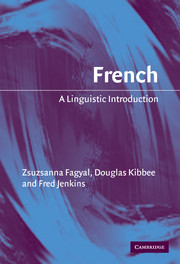3 - Topics in morphology and syntax
Published online by Cambridge University Press: 05 September 2012
Summary
Preliminaries: words and morphemes
Just as Chapter 2 was concerned with the minimal units of sound, this chapter is concerned with the identification, classification, and possible combinations of minimum units of meaning. These minimal units of meaning, called morphemes, can be either bound or free. Morphemes such as affixes (e.g. prefixes and suffixes) are said to be bound because they cannot occur in isolation. By contrast, free morphemes can manifest themselves independently of other morphemes; in such cases, the overlap between a morpheme and an individual word is one hundred percent: très ‘very’, pour ‘for’, garçon ‘boy’, rouge ‘red’, tant ‘so much’, hélas ‘unfortunately’ are all simultaneously single morphemes and single (written) words. Free morphemes also frequently occur with one or more bound morphemes, as in for instance the verb stem chant of the verb form chantait ‘(he) was singing’ or the base word nation in the adjective international that also contains the prefix inter- and the suffix -al. Thus the verb form chantait has at least two morphemes: the verb stem chant- ‘to sing’, and the inflection -ait. The adverb heureusement is a single written word that can be broken down into three morphemes: heureux /œʁ/ ‘happy’ + feminine gender /øz/ + adverbial suffix /mɑ̃/ (on the concept of ‘word’, see section 4.1).
- Type
- Chapter
- Information
- FrenchA Linguistic Introduction, pp. 79 - 138Publisher: Cambridge University PressPrint publication year: 2006

